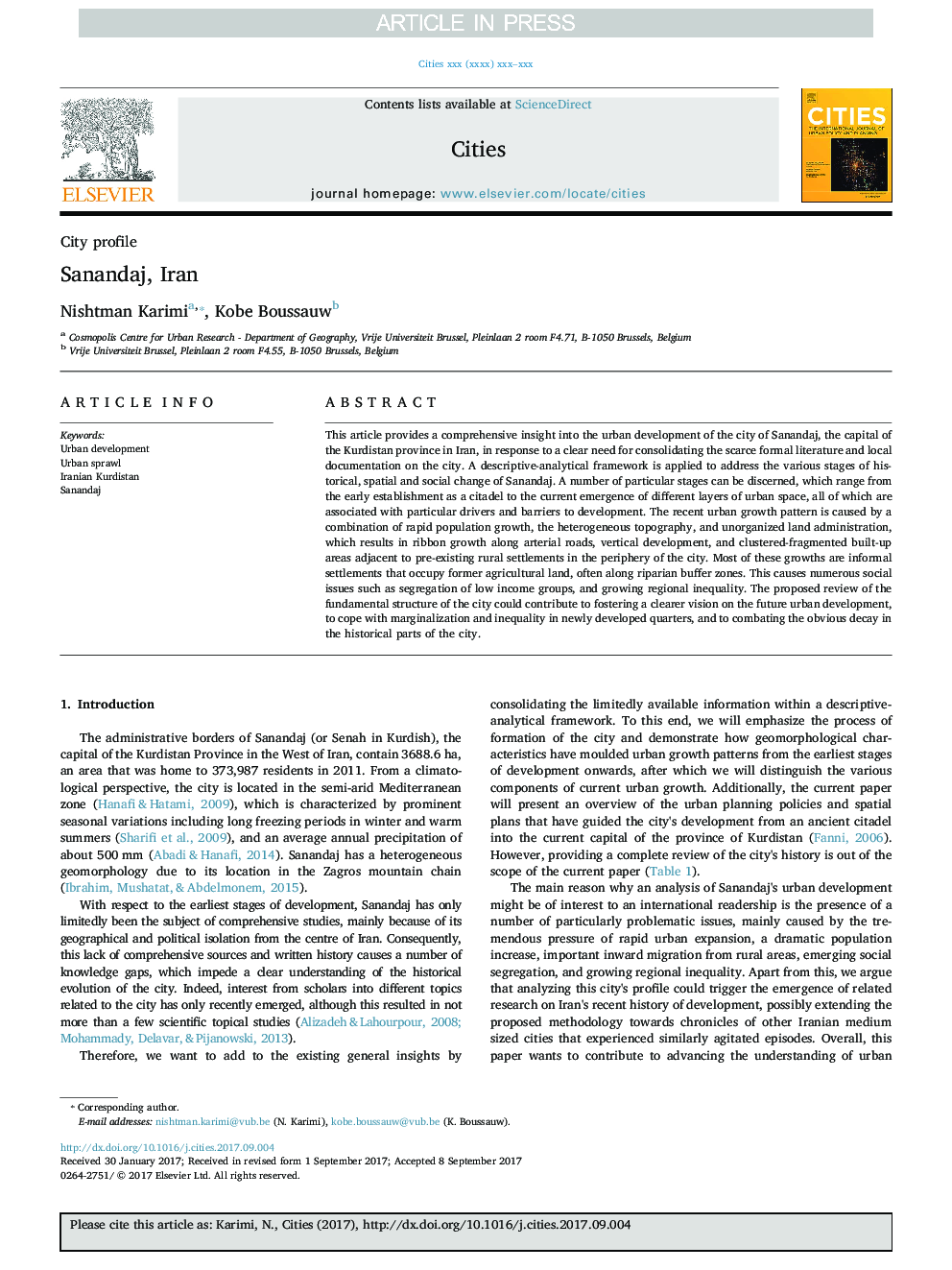| کد مقاله | کد نشریه | سال انتشار | مقاله انگلیسی | نسخه تمام متن |
|---|---|---|---|---|
| 7417710 | 1482323 | 2018 | 13 صفحه PDF | دانلود رایگان |
عنوان انگلیسی مقاله ISI
Sanandaj, Iran
ترجمه فارسی عنوان
سنندج، ایران
دانلود مقاله + سفارش ترجمه
دانلود مقاله ISI انگلیسی
رایگان برای ایرانیان
کلمات کلیدی
توسعه شهری، پراکندگی مراکز شهری، کردستان ایران، سنندج،
ترجمه چکیده
این مقاله بینش جامع در مورد توسعه شهری شهر سنندج، پایتخت استان کردستان در ایران، در پاسخ به نیاز واضحی برای ادغام ادبیات ضعیف رسمی و مستندات محلی در شهر فراهم می کند. چارچوب توصیفی- تحلیلی برای رسیدگی به مراحل مختلف تغییر تاریخی، فضایی و اجتماعی سنندج اعمال می شود. تعدادی از مراحل خاص را می توان تشخیص داد، که از ابتدای تأسیس به عنوان یک ارگاسم تا ظهور فعلی لایه های مختلف فضای شهری محسوب می شود که همه آنها با رانندگان خاص و موانع توسعه همراه است. الگوی رشد اخیر شهری به وسیله ترکیبی از رشد سریع جمعیت، توپوگرافی ناهمگن و مدیریت زمین های غیر سازمانی ناشی می شود که سبب رشد روبان در مسیر جاده های شریانی، توسعه عمودی و مناطق محصور شده خوشه ای شده در مجاورت مناطق روستایی شهری در حاشیه شهر. بیشتر این رشد ها، سکونتگاه های غیر رسمی است که زمین کشاورزی سابق را اشغال می کنند، اغلب در حوزه های بافر ساحلی. این امر منجر به مسائل اجتماعی متعددی مانند جداسازی گروه های کم درآمد و افزایش نابرابری منطقه می شود. بررسی پیشنهادی ساختار اساسی شهر می تواند به تقویت چشم انداز روشن تر در توسعه شهری آینده کمک کند تا با حاشیه سازی و نابرابری در مناطق تازه توسعه یافته و مبارزه با فرسایش آشکاری در بخش های تاریخی شهر، مقابله کند.
موضوعات مرتبط
علوم انسانی و اجتماعی
مدیریت، کسب و کار و حسابداری
گردشگری، اوقات فراغت و مدیریت هتلداری
چکیده انگلیسی
This article provides a comprehensive insight into the urban development of the city of Sanandaj, the capital of the Kurdistan province in Iran, in response to a clear need for consolidating the scarce formal literature and local documentation on the city. A descriptive-analytical framework is applied to address the various stages of historical, spatial and social change of Sanandaj. A number of particular stages can be discerned, which range from the early establishment as a citadel to the current emergence of different layers of urban space, all of which are associated with particular drivers and barriers to development. The recent urban growth pattern is caused by a combination of rapid population growth, the heterogeneous topography, and unorganized land administration, which results in ribbon growth along arterial roads, vertical development, and clustered-fragmented built-up areas adjacent to pre-existing rural settlements in the periphery of the city. Most of these growths are informal settlements that occupy former agricultural land, often along riparian buffer zones. This causes numerous social issues such as segregation of low income groups, and growing regional inequality. The proposed review of the fundamental structure of the city could contribute to fostering a clearer vision on the future urban development, to cope with marginalization and inequality in newly developed quarters, and to combating the obvious decay in the historical parts of the city.
ناشر
Database: Elsevier - ScienceDirect (ساینس دایرکت)
Journal: Cities - Volume 72, Part B, February 2018, Pages 261-273
Journal: Cities - Volume 72, Part B, February 2018, Pages 261-273
نویسندگان
Nishtman Karimi, Kobe Boussauw,
